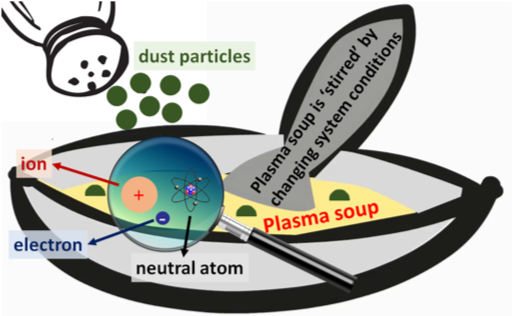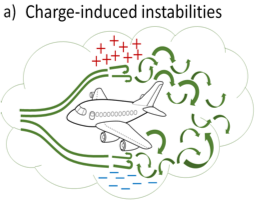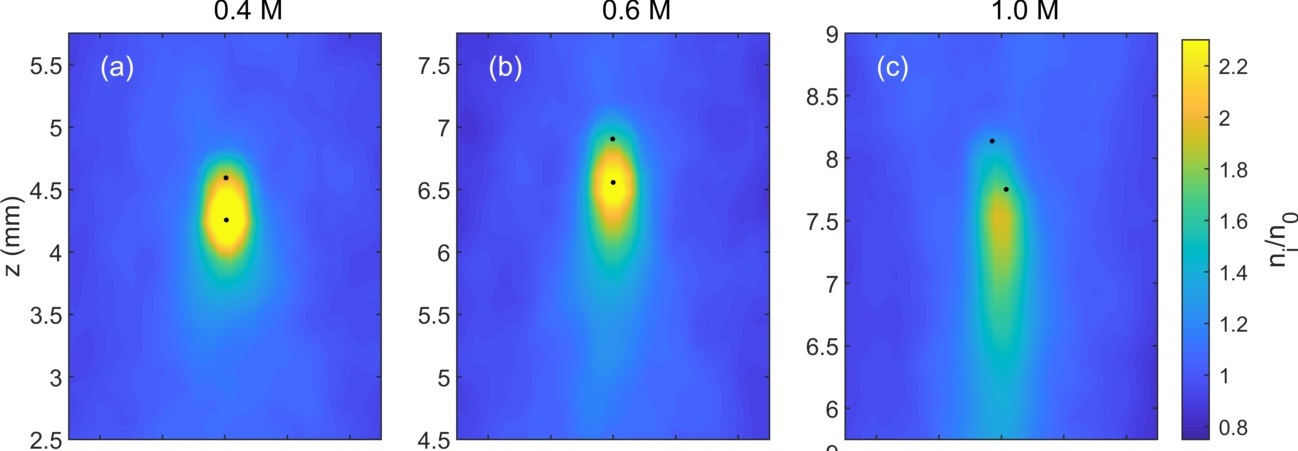Visualizing Matter
Dusty plasma can be visualized as a soup made of tiny particles (ions, electrons, and neutral atoms) and a sprinkle of larger particles (also called dust). Thus, dusty plasmas provide the unique opportunity to study the connection between classical and quantum physics.
Dusty plasma can also be called: complex plasma, dust in plasma, plasma crystal, dirty plasma, fine particle plasma, colloidal plasma, granular plasma, smoky plasma, misty plasma. (Can you remember them all?)
Visualizing Matter
When millimeter (10-3m) to nanometer (10-9m) sized particles are suspended in a plasma environment, they form a new state of multi-component matter, called dusty plasma. As the dust grains can be observed optically, laboratory dusty plasmas provide the ability to examine dynamical processes within the plasma at the scales of individual dust particles. Scientists at CASPER employ dusty plasma structures to investigate the fundamental processes of self-organization, dynamics, and stability in complex matter.
Dust particles immersed within a plasma environment acquire an electric charge. Depending on the plasma environment and the confinement provided by the experiment, the dust particles can self-assemble into a variety of structures including dust crystals, Coulomb balls, strings, and helical string bundles. The Dusty Plasma Lab within CASPER conducts a number of experiments using a variety of experimental platforms, including two GEC RF reference cells, a large modified RF cell, a DC driven discharge chamber (PK-4-BU), an inductively coupled plasma generator (IPG6), and a light gas gun. The diversity of available experimental setups, combined with our high-precision dust perturbation systems (including the S-100 nano-manipulator, Verdi, and femtosecond Ti:Sapphire) allows scientists in our lab to tailor experiments across various areas of research.
Fellows working within the Dusty Plasma Lab can contribute to ongoing projects through experimental work, laboratory diagnostics, experimental, theoretical and numerical support, and are afforded full-time technical support (including matching capabilities and electronics R&D).
Dynamics of Self-Assembling Dust Structures.
a) Multi-chain dusty plasma in polarity-switched DC discharge. b) Ion-dust streaming instability observed in DC neon discharge. (Credit: PK-4-ISS lab.)
Laboratory dusty plasmas exhibit rich many-body dynamics characterized by dust particle structure formation, system phase transitions, and dust / plasma waves and instabilities. CASPER scientists, in collaboration with colleagues from Auburn, Wittenberg, and CalTech universities, are currently investigating how the dynamics of strongly coupled dusty plasma liquids are affected by energy transport and dissipation through the system. The CASPER team is interested in the onset of self-excited or externally driven waves in a DC discharge plasma with polarity-switched electric field, both in gravity and microgravity conditions. In the polarity-switched DC electric field, the dusty plasma clouds are observed to form multi-chain clouds, resembling the structure of electrorheological fluids, which makes them ideal for the investigation of smart materials.
In this project, microgravity data received from the Plasma Kristall-4 (PK-4) experiment on board the International Space Station is compared against the results from a PK-4 reference experiment built in our Dusty Plasma Lab. Theoretical predictions and experimental results are supported by two numerical codes: 1) a two-dimensional Particle-in-Cell with Monte Carlo Collisional (2D PIC/MCC) simulation of the PK-4 DC discharge and 2) an N-body kinetics code modeling Dynamic Reactions of Ions And Dust (DRIAD). (We should have a separate page describing all codes and all devices, which can be linked to this description.)
Faculty & Staff: Truell Hyde, Lorin Matthews, Eva Kostadinova, Jie Kong, Ke Qiao, Jorge Carmona Reyes, Kenneth Ulibarri
Collaborators: Peter Hartmann (Hungarian National Academy of Sciences), Vladimir Nosenko (German Aerospace Centre DLR), Oleg Petrov (Russian Academy of Science), Marlene Rosenberg (UCSD), Edward Thomas (Auburn University), Jeremiah Williams (Wittenberg University), & Paul Bellan (CalTech)
Background Literature CASPER Papers
Onset of Turbulence in Dusty Plasma Liquids.
Understanding the onset of turbulence in charged media is one of the most fundamental challenges of modern science as it affects complex processes such as nuclear fusion, dispersion of chemicals in the atmosphere, formation of atmospheric storms, and aircraft stability. For example, flight turbulence is common, yet its origin can be affected by a number of factors, including wind flow, pressure or temperature gradients, and lightning enhancement in dusty atmospheres. In this project, CASPER scientists investigate the onset of turbulence in dusty plasmas, where both disorder and non-local interactions are present. Specifically, we are interested in the connection between anomalous diffusion at short time scales and the onset of time-evolved turbulence. This is a multi-disciplinary study conducted in collaboration between Baylor University, Texas Tech, and the University of Delaware, which aims to apply novel mathematical techniques to model anomalous particle diffusion in disordered media with non-local interactions. The research team has developed an in-house analysis code employing ideas from spectral theory and fractional calculus. For a given diffusion behavior and concentration of disorder, the analysis code determines the corresponding time-evolved dynamical state of the system based on the evolution of its energy spectrum. The predictions of this novel technique are compared against the results from molecular dynamics simulations as well as experiments employing dusty plasma liquids exhibiting turbulent behavior.
Faculty & Staff: Eva Kostadinova, Lorin Matthews, Truell Hyde
Collaborators: Joshua Padgett (Texas Tech University), and Constanze Liaw (University of Delaware)
Background Literature
CASPER Papers
Non-equilibrium Phenomena.
Ion density maps for a pair of dust particles with different ion flow velocities. (DRIAD simulation)
When dust particles are immersed in streaming plasmas, the trajectories of the plasma ions are altered as they flow past the charged grains. Depending on flow velocity and the magnitude of the charge on the dust grains, ions can be focused into a region downstream of the object, creating a wakefield. The ion wake field has long been shown to cause non-reciprocal interaction between upstream and downstream particles, which makes such systems ideal for the study of non-equilibrium phenomena. In this project, we examine the collective phenomena driving the structure and the symmetry, and dynamical properties of the strongly coupled dust particle systems within directed ion flow. The manner in which the ion flow affects the structure of the ion wakefield, the particle charge, and the stability of the dust structures formed within the plasma are determined through numerical simulations informed by experimental measurements. (Ask if we can put in small animations?)
Faculty & Staff: Truell Hyde, Lorin Matthews, Eva Kostadinova, Jie Kong, Ke Qiao, Jorge Carmona Reyes, Kenneth Ulibarri, Mike Cook
Background Literature
CASPER Papers







